Warrior Square

Southend-on-Sea
History of Warrior Square
Historically,
the
farmland
to
east
of
the
High
Street
was
known
as
the
Grove
Fields
or
Grovefields,
after
the
wooded
area
on
the
top
of
the
cliffs
above
the
old
town
(i.e.
the
top
of
Pier
Hill).
This
land,
stretched
from
the
cliffs
to
the
Southchurch
Road
(to
north)
and
to
Porters
(to
east).
Until
at
least
1869
it
was
all
owned
by
the
Scratton
family
as
part
of
their
Priory
Estate.
Until
then,
others
who
are
described as 'owners' were leasing the land from the Scrattons or tenant farmers thereof.
We
know
of
Grove
Terrace,
that
Scratton
distributed
the
leases
to
the
land
of
Grovefields
to
various
participants
of
the
New
Town
(Royal
Hotel
and
Terrace)
project
in
1793.
Thomas
Holland
added
to
his
own
share
of
the
land
by
buying
some
leases
from
others
but
he
became
bankrupt
whereupon
Daniel
Scratton
sold
the
leases
again
in
1800,
the
majority
of
which
were
purchased
by
James
Heygate.
The
Heygate
family
then
'owned'
all
the
land
from
the
Royal
Hotel
to
Porters
farm.
It
is
not
clear
whether
the
house
at
Porters was included but William Heygate was using it as his Southend residence when he was Lord Mayor of London in 1822.
When
Daniel
Robert
Scratton
sold
his
lands
in
1869,
the
Heygate
family
took
the
opportunity
to
buy
their
leased
land
outright
and
so
owned
all
the
land
on
the
east
side
of
the
High
Street.
This
gave
them
the
ability
to
sell
on
the
land
if
desired
and
following
Elizabeth
Heygate's
death
in
about
1876,
the
Heygate
family
to
sell
their
Grovefield
lands
whilst
retaining
Porters
as
their
local,
family
residence.
The
resultant
sale
in
1880
of
their
properties
on
Grove
Terrace,
including
the
Pier
Hotel
and
Grovefields
to
the
north
enabled the development of Heygate Avenue and York Road in the town.
At
this
time,
the
High
Street
was
still
being
developed
to
south
of
the
station.
The
Luker
Brewery
and
Middleton
hotel
stood
on
the
west
side
of
the
High
Street
to
north
of
the
station
but
the
land
north
of
the
station
on
the
east
side
of
the
High
Street
was
still
farmland.
The
first
plans
for
3
houses
on
Warrior
Square
are
dated
1876.
Essex
Records
Office
hold
4
sale
catalogues
for
various
numbers
of
plots
of
building
land
on
the
'Warrior
Square
Estate'
dated
1881
of
which
2
are
specifically
dated
in
July
and
September
of
that
year.
These
included
plots
on
the
High
Street
and
one
refers
to
a
'Warrior
Square
Road'.
This
gives
us
the
date
when
we
can
say that Warrior Square was built.
The
building
plans
for
the
Victoria
Hospital
were
dated
1887
and
it
is
worth
noting
that
the
hospital
resulted
from
public
subscriptions.
Two
further
sale
catalogues
are
dated
1890
and
there
are
plans
for
a
house
and
offices
in
that
year
but
most
of
the
building
plans
date
from
1891
and
through
to
about
1906.
Even
so
a
1897
map
shows
properties
existing
only
on
the
south
side
of
the
square
(between
the
High
Street
and
the
Victoria
Hospital)
so
that
side
of
the
square
was
built
first.
That
map
was
probably
surveyed
about 1895 and most of the square itself was probably built in the late 1890s to early 1900s.
Such
squares
are
typical
of
late
Victorian
residential
developments
near
town
centres.
Prittlewell
Square
is
another
example.
Land
prices
were
high
in
areas
close
to
the
town
centres
yet
the
intention
was
to
build
quality
housing
for
those
making
money
in
the
town
who
needed
accommodation
nearby.
The
solution
was
to
build
on
smaller
plots
so
that
houses
were
closer
together
and
this
left
space
only
for
each
property
to
have
a
small
yard
rather
than
a
garden.
To
make
up
for
the
lack
of
private
gardens,
the
square
in
the
middle
of
the
houses
was
landscaped
as
a
private,
communal
garden
for
the
use
of
residents
only.
This
also
served
the
custom
of
the
Victorian
middle
classes
to
take
an
evening
or
Sunday
stroll,
dressed
in
their
finest
clothes
to
show
themselves
and
greet
their
neighbours.
Thus,
Warrior
Square
was
originally
a
garden
for
the
residents
who
lived
there
and
who
paid
1
guinea
per
year
for
the
use
thereof.
The
same
was
true
for
Prittlewell
Square
(with
the
bowling
green
providing
allotments)
and
also
the
Shrubbery
which,
although not technically a 'square', provided a private garden for the residents of Royal Terrace.
To
some
extent,
the
nature
of
the
square
has
changed
over
the
years
in
accordance
with
the
public
transport
arrangements.
From
1902
the
trams
that
brought
shoppers
and
others
to
the
town
centre,
ran
down
the
High
Street
to
a
terminus
outside
the
Middleton
Hotel.
Warrior
Square
remained
a
relatively
quiet
residential
area
other
than
the
building
of
a
skating
rink
(1909)
which
became
the
Strand
Cinema
in
1911.
An
indoor
shopping
arcade
(the
Strand
Arcade)
was
also
built
adjacent
to
the
cinema
on
its
south
side.
Although
both
buildings
had
their
main
entrances
on
Warrior
Square
they
also
had
rear
entrances
on
Leather
Lane
which
could
be
accessed from the High Street via a passageway or from an exit at the back of the large Keddies store.
The
tram
system
at
that
time
consisted
of
single
tracks
with
occasional
passing
spaces.
But
as
the
trams
became
busier
the
tracks
were
gradually
doubled
(from
1907
to
1920)
to
allow
more
cars
to
run.
The
High
Street
trams
were
already
becoming
problematic
for
other
traffic
and
so
it
was
not
doubled.
Instead
a
tram
track
was
built
through
Warrior
Square
connecting
the
Southchurch
Road
and
High
Street
lines
to
form
a
loop
that
trams
went
around
without
needing
to
change
direction.
The
main
tram
stop
was
then
in
Warrior
Square
and
this
eventually
replaced
the
High
Street
terminus
stop.
Warrior
Square
then
became
a
busy
place.
By
1942,
as
trackless
vehicles
replaced
the
tram
route,
trolley
buses
ran
through
Warrior
Square.
In
the
post-WW2
years
and
by
the
early
1950s
the
trolley
bus
routes
had
followed
the
tram
routes
in
closing
down.
By
then,
buses
were
running
down
the
High
Street
and
the
use
of
cars
was
increasing
and
so
Warrior
Square
once
again
became
a
quiet
place,
where
I
can
remember
sitting
for
a
packed
lunch
with
my
parents
as
a
respite
from
the
bustle
of
a
Saturday
High
Street
shop.
In
this
period,
many
of
the
houses
around
the
square
were
occupied
by
offices
of
professional
services
including
solicitors,
insurance
brokers,
building
societies
and
dentists.
This
tranquil
time
lasted
until
December
1966
when
the
north
end
of
the
High
Street
was
pedestrianised
and
all
through
traffic
was
diverted
via
Warrior
Square.
By
1970
a
main
bus
stop
was
located
at
the
entrance
to
the
square
itself
and
across
the
road
outside
what
was
then
a
rear
entrance
to
the
Keddies
store
extension.
Warrior
Square
had
again
become
a
busy,
noisy
place.
In
later
developments
more
of
the
High
Street
was
pedestrianised and Warrior Square West was extend southwards to a new bus station as Chichester Road.
You
may
ask
the
question
“why
is
the
area
called
Warrior
Square.”
No
definitive
answer
could
be
found.
I
could
find
no
historical
feature
of
the
land
that
suggested
a
reason
for
the
name.
Google
searches
showed
that
the
name
'Warrior'
was
also
used
as
a
street
name
elsewhere
in
Victorian
times,
most
notably
a
similar
'Warrior
Square'
in
St
Leonards.
Some
of
these
may
be
borrowed
names
and
I
note
that
many
street
and
place
names
that
I
know
from
Southend
also
exist
at
other
resorts.
Even
so,
it
seems
that
'Warrior'
represents
an
important
part
of
Victorian
iconography.
The
name
'Warrior
Square'
first
appears
in
Essex
Records
in
1876
on
the
plans
of
3
houses
to
be
built
there.
However,
you
cannot
be
certain
that
the
name
or
date
was
not
a
later
revision
of
the
record's
reference.
The
square
itself
was
built
in
1881
and
that
happens
to
be
the
date
when
HMS
Warrior
was
hauled
to
Scotland
to
be
decommissioned
(in
1883).
The
ship
had
been
placed
'in
reserve'
from
1875.
This
was
the
second
ship
to
bear
that
name
and
was
famous
for
being
the
Royal
Navy's
first
armour-plated,
iron-hulled
warship,
so
famous
that
she
had
undertaken
a
publicity
tour
of
Great
Britain
in
1863.
The
naming
of
Warrior
Square
being
coincident
with
the
end
of
service
of
this
great
warship
suggests
the
street
name
was
intended
as a legacy of HMS Warrior. That would be my best guess.
Other
than
its
involvement
in
the
tram
system
and
as
the
site
of
at
least
one
air
raid
shelter
in
WW2,
the
primary
historical
features
of Warrior Square were the cinema and the hospital (later clinic).
Skating Rink/Cinema
The
original
structure
was
built
as
a
skating
rink
in
Warrior
Square
in
1909.
In
1911,
it
opened
as
the
Kinemacolour
Theatre
(cinema).
Shortly
after
opening,
it
became
the
first
cinema
to
show
colour
films
in
the
borough
using
a
process
introduced by Mr A. Simpson of Kensington Road, Southend.
In
1914,
the
cinema
was
re-named
the
Warrior
Square
Picture
Theatre
and
in
1920
it
was
re-named
again,
this
time
as
the
Strand.
The
cinema
was
destroyed
by
fire
in
1926
and
rebuilt.
It
was
rebuilt
as
the
New
Strand
cinema
to
open
in
1928.
In
1955
the
cinema
was
taken
over
by
the
Essoldo
circuit
and
had
stereo
sound
installed.
Locally,
it
was
known
as
the
Southend
Essoldo
to
distinguish
it
from
the
cinema
of
the same name on London Road, Westcliff.
The
cinema
finally
closed
in
May
1960
to
be
purchased
by
Keddies
for
£35,000.
It
was
then
gutted
and
fitted
out
as
the
Supa-Save
supermarket
that
opened
in
the
early
1960s.
It
was
later
demolished
(c1970)
and
rebuilt
as
an
extension
to
the
Keddies store, providing the store with an entrance on Warrior Square.
[Source: "The Dream Palaces of Southend" by Roy Dilley]
Victoria Hospital
The
Victoria
Hospital
located
in
far
east
extremity
of
Warrior
Square
was
formally
opened
on
30th
May
1888
by
Mrs
Carne
Rasch
wife
of
the
local
MP.
For
the
size
of
the
population
of
Southend
and
large
numbers
of
visitors
this
8
bed
sanatorium
was
woefully
inadequate,
but
at
least
it
was
a
start,
providing
the
town
with
more
than
it
had
before.
The
cost
of
building
the
hospital
and
equipping
it
out
came
under
the
planned
budget
of
£2,500.
At
a
time
long
before
the
NHS
came
along,
the
hospital
needed
to
survive
through
fundrasing
and
pledges
of
those
goodwilled
citizens
in
the
community.
As
the
hospital
established
itself
within
the
community
it
not
only
provided
a
22
bed
ward
and
a
children's
ward
(in
1906)
but
also
provided
nursing
services
into
the
community.
It
was
comforting
to
see
that
the
hospital
built
on
its
starting
budget,
managed
to
secure
funding
in
full
to
keep
it
going
for
many
years.
In
1900
during
the
Boer
War
three
beds
were
put
at
the
disposal
of
the
Mayor
for
the
use
of
wounded
troops
or
those
invalided
out
of
the
military,
fortunately
this
offer
was
never
taken
up.
It
was
quickly
realised
the
Victoria
Hospital
would
become
a
key
bequeathment
from
beneficiaries
of
the
hospital's
services,
as
well
as
those
that
worked
tirelessly
within
the facility.
The
building
was
considerably
extended
over
the
years.
When
Southend
General
Hospital
opened
in
1932
on
the
Prittlewell
Chase
site,
the
Victoria
Hospital
became
the
Municipal
Health
Centre
although
many
will
remember
it
as
the
Warrior
Square
Clinic
and
its
notoriety
as
the
location
of
the
Schools'
Dentist
in
the
post
war
years. The hospital closed and was demolished in the 1970s.
The
Warrior
Square
Gardens
originally
formed
the
centre
piece
of
a
13
acre
site
located
just
off
the
High
Street.
In
1881
the
site
was
sold
off
in
plots
for
the
development
of
shops
and
flats.
The
gardens
located
in
the
middle
originally
housed
tennis
courts
a
croquet
lawn
and
a
“tastefully”
laid
out
garden
area
consisting
of
flowerbeds
and
shrubs.
These
gardens
were
built
for
the
exclusive
use
of
residents
of
the
new
development
for
the
annual
subscription
fee
of
one
guinea.
Over
time
the
private
gardens
became
more
open
to
the
public,
the
tennis
court
and
croquet
lawn
were
removed
and
the
whole
park
was
given
over
to
grass,
trees
and
shrubs.
The
east
side
of
the
square
was
redeveloped
some
years
later
to
include
the
Warrior
Square
swimming
pool
(closed
2010
and
later
demolished) and a car park, the gardens had become somewhat unloved and were not an inviting place.
The
now
defunct
redevelopment
company
Renaissance
Southend
made
a
successful
bid
for
funding
to
undertake
a
complete
restoration
of
the
dilapidated
gardens,
with
the
funding
coming
from
the
Homes
&
Communities
Agency.
Once
the
funds
were
secured and a design for the makeover laid out the gardens gates were closed to the public with work beginning on 15th March 2010.
The
gardens
remained
closed
to
the
public
for
over
a
year,
finally,
after
a
£1.8million
make
over
the
gardens
reopened
to
the
public
on Saturday 28th May 2011.
Work
carried
out
included
the
removal
of
a
small
number
of
trees
to
bring
more
natural
light
in
to
the
gardens,
the
removal
of
hedges
and
fences
and
the
planting
of
a
number
of
new
trees.
Also
included
in
the
restoration
were
a
number
of
raised
flowerbeds,
new
seating
and
for
the
first
time
the
gardens
were
lit
with
its
own
lights.
Further
editions
to
the
gardens
included
lime
walk
on
line
stone
paving
and
a
wooden
decking
pathway
underneath
a
line
of
lime
trees.
A
new
café
was
also
included
featuring
a
unique
folding
roof
that, looked like a flower, when the café was open the “petals” are open when the café closed the petals folded down.
1970 Warrior Square Swimming Pool
2021
View
with
Warrior
Square
Swimming
Pool
demolished, area now a car park
Late
1890s
Victoria
Hospital,
site
later
to
become
part of the Warrior Square Swimming Pool site
1914
-
1920
Strand
Cinema,
originally
the
“Rinkeries”
skating rink
1969
Times
Furnishing
Building.
Trees
in
Warrior
Square.
Warrior
Square
Swimming
Pool
in
the
distance
2021 Warrior Square Garden
2021 Glasshouse Café Warrior Square
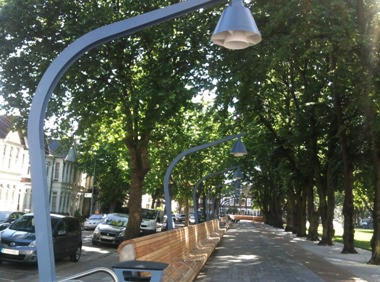
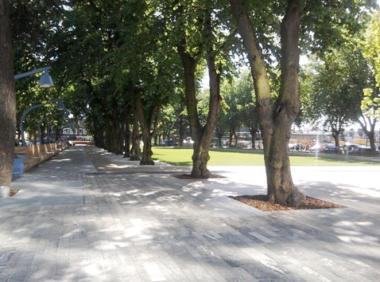
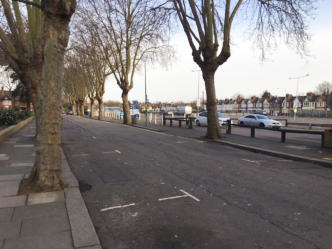
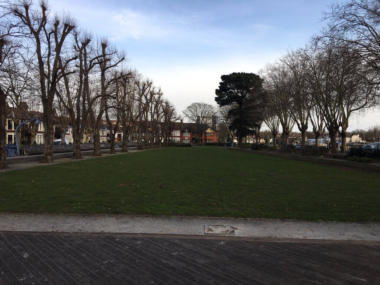
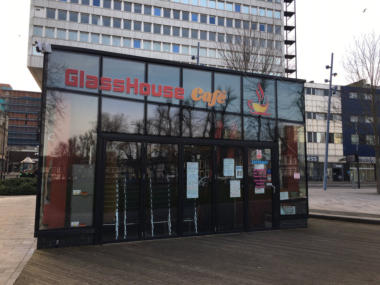
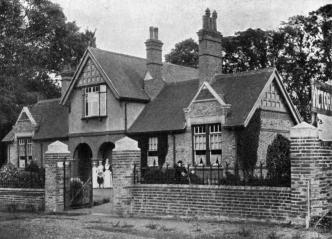
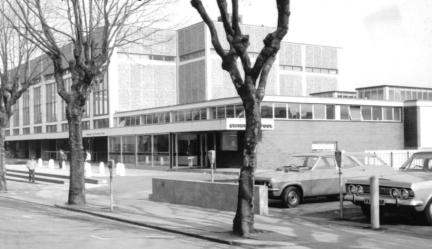
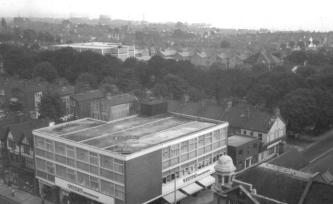
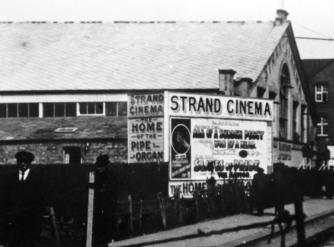
Warrior Square Swimming Pool
April 1967: Work starts on the new pool, March 1969: Construction completed, 20th May 1969: Official opening.
Official opening order of events:
11:00am:
Her
Royal
Highness
The
Duchess
of
Kent,
accompanied
by
Miss
Fiona
Pilkington
Lady-in-Waiting,
will
arrive
at
Southend
Municipal Airport by helicopter and will be received by her Majesty’s Lieutenant of Essex Colonel Sir John A Ruggles-Brise.
Her Majesty’s Lieutenant will ask leave to present:
The Chief Constable of Essex & Southend-on-Sea Joint Constabulary Mr J. C. Nightingale.
The Vice Sheriff of Essex The Honourable R. C. Butler & the Honourable Mrs Butler.
The Vice Lieutenant of Essex Major G. N. Capel-Cure and Mrs Capel-Cure
The Clerk to the Lieutenancy Mr J. S. Mills and Mrs Mills.
Mrs J. C. Nightingale.
Her Majesty’s Lieutenant will then present to Her Royal Highness:
His Worship the Mayor of Southend-on-Sea Alderman F. G. Feather.
The Mayoress of Southend-on-Sea Mrs Feather.
The Recorder of Southend-on-Sea Mr M. J. Morris and Mrs Morris.
The Town Clerk of Southend-on-Sea Mr Archibald Glen & Mrs Glen.
The Airport Commandant Mr A. P. Cusworth.
11:04am: Her Royal Highness will drive in procession along the following route:
Manners Way, Cuckoo Corner, Victoria Avenue, Ring Road, Southchurch Road, Warrior Square.
In
the
event
of
inclement
weather
Her
Royal
Highness
will
journey
by
cat
direct
to
the
Swimming
Pool
(where the above mentioned presentations will take place).
11:15am: Her Royal Higness will arrive at the Swimming Pool, where His Worship the Mayor will ask leave to present:
The Deputy Mayor of Southend-on-Sea Alderman T. O. Ewart-James.
The Mayor Elect of Southend-on-Sea Alderman Mrs V. E. Smith.
Sir Stephen McAdden CBE, MP.
Mr Paul Channon MP.
The Borough Architect Mr P. F. Burridge OBE.
The Baths Manager Mr R. Sreenan.
The Contractors Representative Mr P. H. Bates.
11:17am: Her Royal Highness will take coffee with the assembled guests.
11:30am:
her
Royal
Highness
will
be
escorted
by
his
Worship
the
mayor
into
the
dais
and
will
be
presented
with
a
bouquet
by
Miss
Celia Feather, younger daughter of the Mayor and Mayoress.
His Worship the Mayor will welcome Her Royal Highness and invite her to declare open the Swimming Pool.
11:35am: Her Royal Highness will graciously respond to this invitation.
11:38am:
His
Worship
the
Mayor
will
call
upon
the
Deputy
Mayor
Alderman
T.
O.
Ewart-James
to
propose
a
vote
of
thanks
to
Her
Royal Highness.
11:40pm:
A
short
diving
display
will
be
given
by
Olympic
and
international
divers,
John
Miles,
Alan
Rogers,
Kevin
O’Brian
and
Mike
Cannon, of the Ilford Diving Display team.
11:50am:
Her
Royal
Highness
will
be
accompanied
by
His
Worship
the
mayor
and
guests
to
the
entrance
foyer
where
he
will
invite
her to unveil a commemorative plaque.
11:55am:
Her
Royal
Highness
will
leave
the
Swimming
Pool
and
proceed
by
car
to
the
County
Borough
boundary
by
way
of
Warrior
Square, High Street, Pier Hill, Western Esplanade, Chalkwell Avenue and London Road A13.
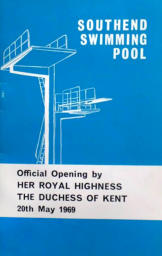
Warrior Square
Swimming Pool Opening
Booklet
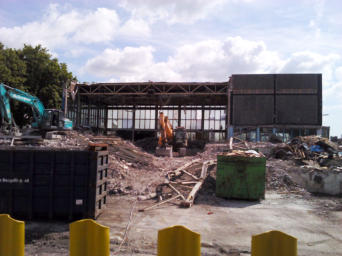
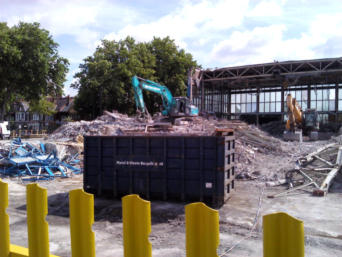
24th June 2011 Pool building being demolished. Pictures by courtesy of Martin Clemesha
New lighting and seats make the gardens more inviting
New Paths and Decking
Southend Timeline Southend-on-Sea © 2009 - 2024. All Rights Reserved



Southend-on-Sea’s No 1 History Website! Documenting The Town & The Townspeople

Now Incorporating The Sea Of Change Website
Website Info:


Chalkwell ▪ Eastwood ▪ Leigh-on-Sea ▪ Prittlewell ▪ Shoeburyness ▪ Southchurch ▪ Thorpe Bay ▪ Westcliff-on-Sea
SOUTHEND CITY
































































